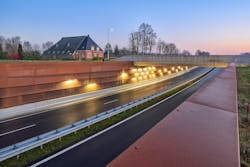Cherishing the Night Landscape
A recent project in Friesland, Netherlands, proves that preserving public safety simultaneously with darkness may be successfully achieved. Here are some of the main aspects of a design that tastefully melds the roadscape into the landscape during the daylight hours and preserves the feeling of night after dark.
NEXT and Arup’s lighting design not only minimizes ecological impact, it resulted in lower energy expenditure and material for the cables and the overall cost of the new infrastructure:
- Motorists are guests in the landscape and light their own way after dark.
- The design provides safety through visual cues such as refl ection and low light where necessary; for instance, a trafficc circle is marked with a lamppost and a crosswalk where a pedestrian or cyclist may intersect with the path of car travel is marked with small pole light.
- Aesthetically, the project chose to use wooden lampposts to form a signature identity of that area while minimizing the intrusiveness of a highway.
- Architectural and cultural landmarks, such as the corten steel of the Doniawei, are accentuated with lighting to provide an intuitive sense of location along the route.
